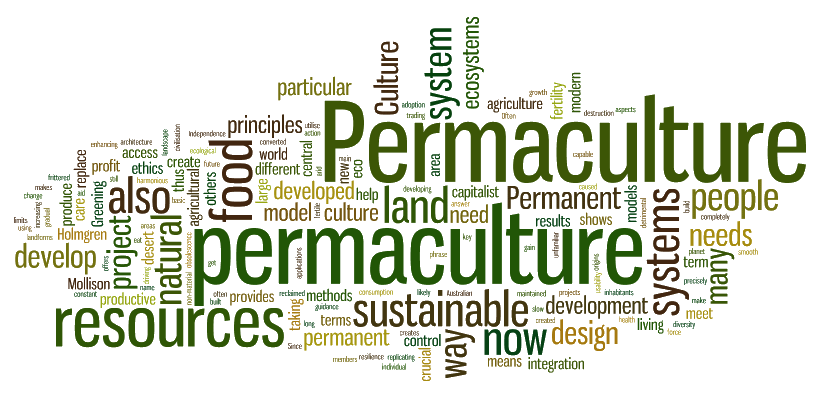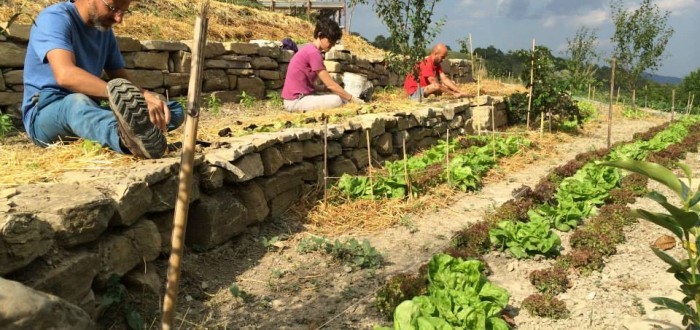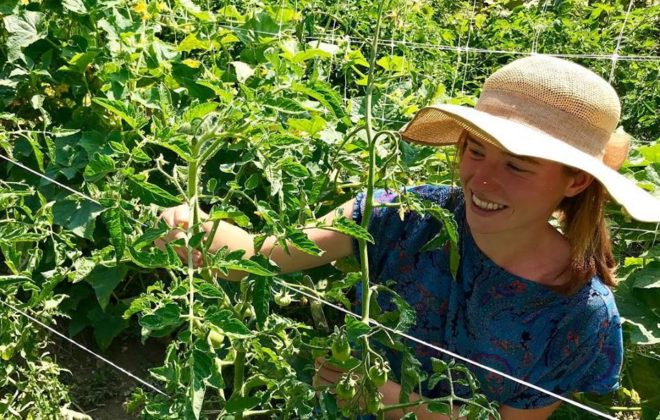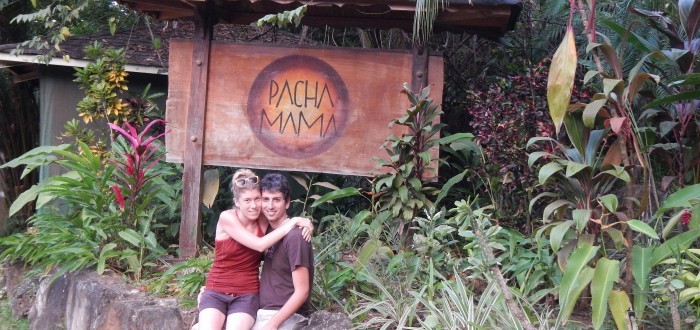Permaculture: where are we in Italy
By Elena Parmiggiani
Many are the small and big organisations that apply and communicate this method and the values that it shares.
Several months have passed since my latest interview to Massimo Candela (October 2014), president of the Italian Academy of Permaculture (Accademia Italiana di Permacultura), in which we discussed the most interesting organizations in Italy. Let’s see how the situation has evolved.
There at least 3 associations at national level that deal with permaculture:
- The Italian Academy of Permaculture (permacultura.it), established thanks to the British Permaculture Academy founded by Andy Lagford (now co-founder of Gaia University) and Richard Wade, who assists and organises the Italian course and sets up networks at national and international level among students, apprentices and graduated people;
- The Italian Institute of Permaculture (Istituto Italiano di Permacultura) founded by Pietro Zucchetti, that organises permaculture courses;
- The World Permaculture Association, promoted by Giuseppe Tallarico and established through the direct cooperation with the Australian Permaculture Research Institute. It offers courses with international professionals such as Rhamis Kent (PRI AU), John D. Liu (Chinese documentarian) and its aim is promoting and spreading food production by following permaculture principles.
There are also hundreds of associations that not only organise courses, but at the same time create projects both in the countryside and cities thanks to permaculture principles and values. Speaking of which, I’d like to mention at least 2 organisations that are special to me: the “Fruttorti” of Parma and Reggio Emilia, informed groups of citizens who want to give everyone the chance to get back the ability and responsibility of taking care of their own city, life and planet in a moment when system crisis and uncertainty seem to take over. The second organisation is “Coltivare condividendo”, in which Tiziano Fantinel and many other citizens are engaged in saving seeds and biodiversity. They are helping many farmers to value and rediscover local varieties almost disappeared. I only mention 2, but local organisations are many more and I invite you to explore your surroundings and find hidden treasures not so far from us.
In the permaculture world, in this network that is connected to many others that deal with the same or similar topics, we can include thousands of passionate, curious and active people who create the most disparate projects, from the classic farms to B&Bs, or natural cosmetics and remedies productions.
The many activities of Permaculture
At the many courses and meetings I participated to, people usually have very little in common, they come from the most disparate life experiences and have very different jobs. However, the features they have in common are the desire to change their life, to find a more human dimension, to slow down the hectic rhythm of a consumer society and to become self-sufficient. People get interested in this topic because they seek for healthier and natural alternatives to everything: agriculture, diet, wellbeing, birth and degrowth. The way they get to permaculture varies a lot and it depends on people’s personal interests. I met people who approached this method while they were learning to make bread or yogurt enzymes.
The most interesting entities in agriculture have been created by people who approached cultivation, harvest, production and breeding, men and women who have created a real project starting from a simple idea. The following list includes the projects that I had the pleasure to know and that I reckon are very interesting:
- Region of Piemonte – Orto di Carta, by Nicola and Noemi. Biointensive gardening.
- Region of Lombardia – Terra Organica, by Matteo Mazzola. Biointensive gardening and Keyline.
- Region of Veneto – Terre Vive, by Dimitri Zuccolotto. Natural and biointensive gardening.
- Region of Trentino Alto Adige – Molino dei Lessi, by Emma and Enzo. Viticulture.
- Region of Emilia Romagna – Azienda Agricola Verde Lattuga, by Paolo and Laura. Synergistic Agriculture.
- Region of Tuscany – Fattoria natural Stabbiati, by Angelo and Petra. Synergistic and organic agriculture, sheep and goat breeding for milk production, food forest.
- Region of Calabria – Primigenia, by Enrico Tassone and Nicky Brusco. Vegetable gardens and goat breeding for milk production.
- Region of Sicily – Casa di Paglia Felcerossa, by Toti and Tiziana. Synergistic and natural vegetable gardens.
It’s important to notice how many of the people who start approaching permaculture in Italy then find themselves creating projects abroad. An interesting example, although it’s not properly concerning agriculture, but it’s part of a permaculture design, is permacultura-transizione.com, the website created by Marco Matera and Flavio Troisi. The aim of the project is promoting permaculture and it contains dozens of articles translated into Italian and original contents.
EUPC: European Permaculture Convergence
In order to have an overview of the various permaculture projects in Italy and abroad, next year in September it will be possible to participate to the EUPC, the European Permaculture Convergence that takes place every 2 years in a European country.
During the Convergence permaculture experts from all Europe share their knowledge, experience, methods and projects about permaculture and associated topics. During these days, permacultors from the hosting country organize several events such as meetings, workshops, short communications, storytelling, practical activities and music and dance shows, everything abiding by the permaculture principles.
The latest Convergence took place in 2016 in Italy, in the city of Bolsena and it closely involved the whole citizenry with the idea of “influencing” the local community. The municipality made available public buildings, classrooms, deconsecrate churches and even the Roman amphitheatre for the events of the Convergence. Some of the topics discussed during the EUPC were: social permaculture, soil regeneration, green building, economy, cereal cultivation without ploughing, food fermentation, designing, eco-villages, etc.
Bolsena’s vegetable gardens
A special mention goes to Bolsena’s vegetable gardens. Thanks to the cooperation between Anna Satta and Anna Benzoni (who follow Emilia Hazelip’s synergistic agriculture www.agricolturasinergica.it) and Max Petrini (graduated at the Italian Permaculture Academy), have been realised vegetable gardens and experimental cultivations of cereals on about 3500 square meters of land, employing different techniques also very ancient and local (irrigation system). During the days of the Convergence these vegetable gardens were used as open-air laboratories. The aims are creating in the future a local network of vegetable gardens that only use highly sustainable techniques and limiting the economic resources needed to start them.
A growing culture
From 2009, when I first approached permaculture, many thigs have changed and permaculture is getting more popular among people. National television channels talked about it few times, articles have been written on national newspaper, events and meetings have been organized and now also a Festival. Many are the activities that promote it increasingly. What I appreciate is that always more people adopt it as a designing and problem-solving method and not only as “alternative horticulture”, or “self-sufficiency and autarky”, or even worse, as “absolute ethic” in which we all have to be identical and conform to a single person’s morality. A permanent, not-too-tight and not idealistic culture could be the key for a sustainable life with people-oriented social relations that we need so desperately.
Witnesses of this need for a change are the many people in Italy who are changing their life for a different future to be realised also through permaculture principles.
Newsletter
ARGOMENTI
- Activities (8)
- Attività (10)
- Attrattive (16)
- Cosa fare (22)
- Farm products (4)
- Fattoria dell'autosufficienza (51)
- Fattoria dell'autosufficienza (39)
- Fauna (8)
- Flora (5)
- I nostri modelli (14)
- Istruzioni per viaggiare (2)
- News (63)
- News (96)
- Our models (14)
- Permacultura (30)
- Permaculture (23)
- Prodotti della fattoria (4)
- Senza categoria (2)
- Senza categoria (4)
- Things to do (22)
- Tourist attractions (15)







